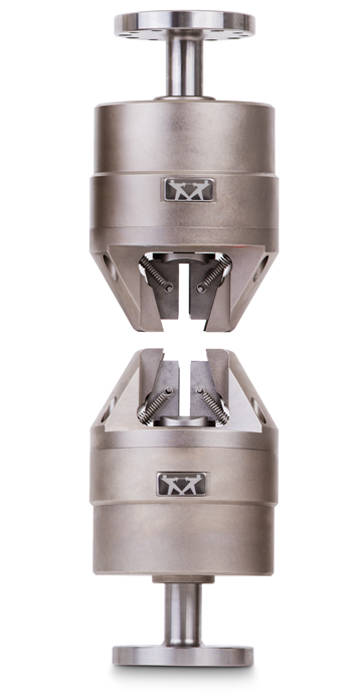±3 kN, ±25 Nm Pneumatic Fatigue-Rated Wedge Action Grips
2742-205

Designed to suit ElectroPuls® test instruments, the 2742-205 pneumatic wedge action grips are suitable for tension, compression, torsion and reverse-stress testing on a wide range of specimens and materials. The grips are pneumatically operated directly from the machine handset and the open-fronted design provides easy specimen insertion, positioning and clamping.
Principle of OperationThe single-acting wedge action principle of these grips is designed to clamp a specimen without applying a compressive load, which could cause a specimen to buckle. The retracting movement of the grip bodies helps to reduce compressive loads that are normally caused when clamping specimens.
The open front design permits quick and easy changing of specimens and jaw faces. Jaw faces optimize gripping performance whilst the serrated faces are designed to minimize damage to the specimen surface
Principle of OperationThe single-acting wedge action principle of these grips is designed to clamp a specimen without applying a compressive load, which could cause a specimen to buckle. The retracting movement of the grip bodies helps to reduce compressive loads that are normally caused when clamping specimens.
The open front design permits quick and easy changing of specimens and jaw faces. Jaw faces optimize gripping performance whilst the serrated faces are designed to minimize damage to the specimen surface
Application Range
- Types of loading: Tension, compression, torsion or reverse-stress testing
- Specimen geometries: Flat or round specimens
- Specimen material: Metallics, plastics, composites, biomaterials
- Temperature range: +10 to +40°C (50 to 104°F)
Features
- Dynamic Linear Capacity: ±3 kN (±674 lbf)
- Dynamic Torque Capacity: Up to ±25 Nm (±221 lbf.in)
- Modular flange mounting design is directly compatible for use on all new E3000 and E10000 variants
- Independent upper and lower jaw faces opening and closing via the handset
- Enhanced usability thanks to software feedback of grip status
- Enhanced control and repeatability of specimen gripping
- Suitable for linear and torsion, including full reverse-stress dynamic testing
- Open-fronted design for quick and easy specimen insertion from the front
- Self-tightening, moving body wedge design eliminates slippage and prevents specimen loading
- Interchangeable jaw faces for gripping different materials and specimen geometries and sizes
- Secure operation thanks to built-in adjusters that ensure there is no rotary backlash